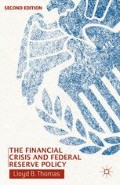Abstract
Banking crises go back hundreds of years to the origin of fractional reserve banking. In such a system, banks and other depository institutions maintain only a small fraction of their deposit liabilities in the form of reserves, defined loosely as cash on hand and deposits in other banks. As the story is told in textbooks, fractional reserve banking began with English goldsmiths. Turning the clock back nearly 400 years, the East India Company and other recently chartered British organizations involved in long-distance trade began amassing large amounts of gold around 1650 AD. These companies, along with merchants and other wealthy individuals in seventeenth-century London, needed a place to store their precious metals—mostly gold and silver coins. Goldsmiths were private firms that originated as jewelers. Because they owned impregnable safes in which to store their jewelry, goldsmiths provided the logical place in which to store the increasing stocks of gold and silver.
Access this chapter
Tax calculation will be finalised at checkout
Purchases are for personal use only
Preview
Unable to display preview. Download preview PDF.
Notes
For a detailed study of nineteenth century U.S. banking panics, see Charles Calomiris and Gary Gorton, “The Origins of Banking Panics: Models, Facts, and Bank Regulation,” in R. Glenn Hubbard, Financial Markets and Financial Crises (Chicago, IL: University of Chicago Press, 1991).
The Panic of 1907 took a terrible toll on Barney and his family. Although the crisis was over by then and he remained a wealthy man, Barney died in his home of a self-inflicted gunshot on November 14, 1907. For a fascinating account of the personalities and events involved in the Panic of 1907, see Robert Bruner and Sean Carr, The Panic of 1907:Lessons Learned From the Market’s Perfect Storm (Hoboken, New Jersey: John Wiley and Sons, 2009).
Copyright information
© 2013 Lloyd B. Thomas
About this chapter
Cite this chapter
Thomas, L.B. (2013). The Panic of 1907 and the Savings and Loan Crisis. In: The Financial Crisis and Federal Reserve Policy. Palgrave Macmillan, New York. https://doi.org/10.1057/9781137401229_3
Download citation
DOI: https://doi.org/10.1057/9781137401229_3
Publisher Name: Palgrave Macmillan, New York
Print ISBN: 978-1-137-37077-8
Online ISBN: 978-1-137-40122-9
eBook Packages: Palgrave Economics & Finance CollectionEconomics and Finance (R0)

